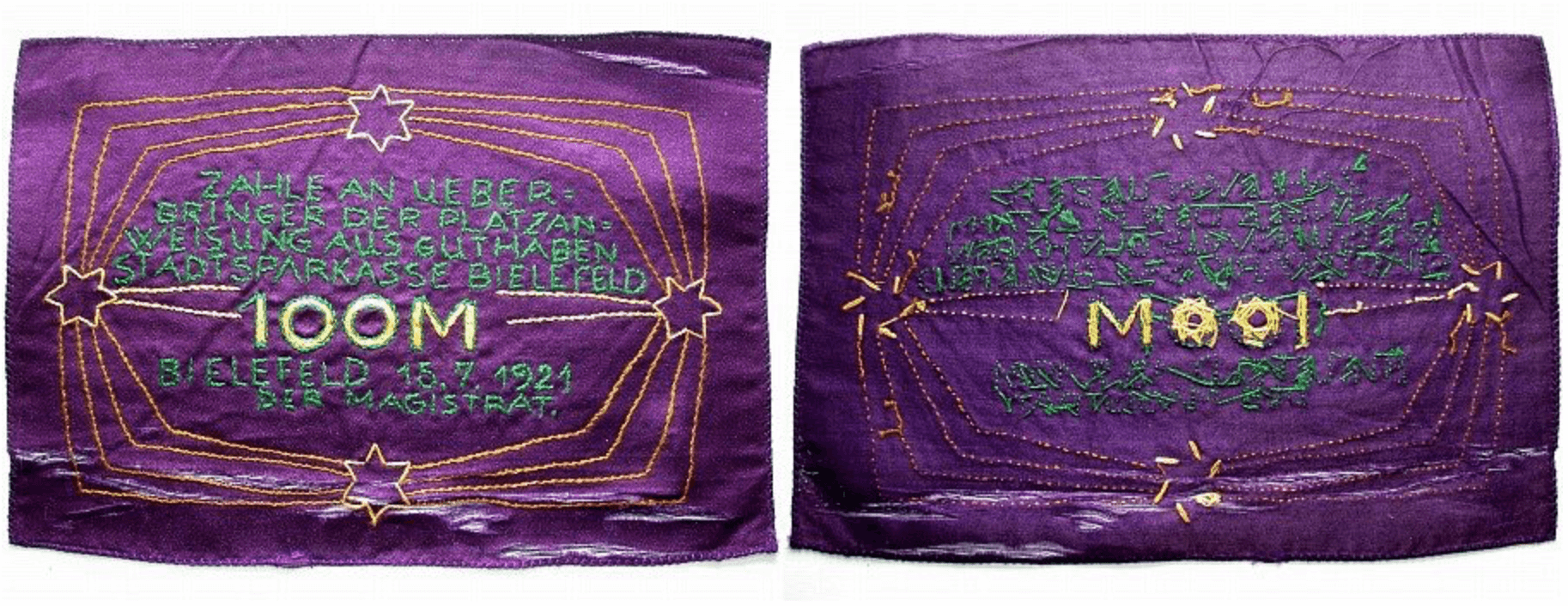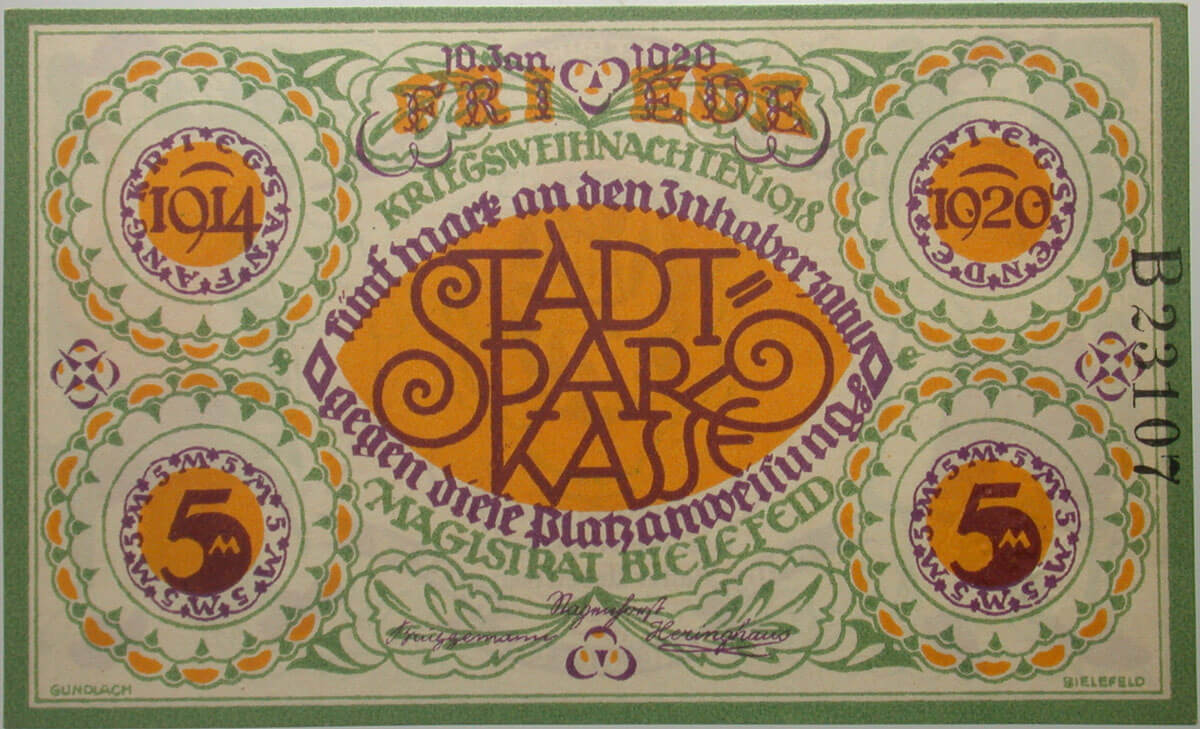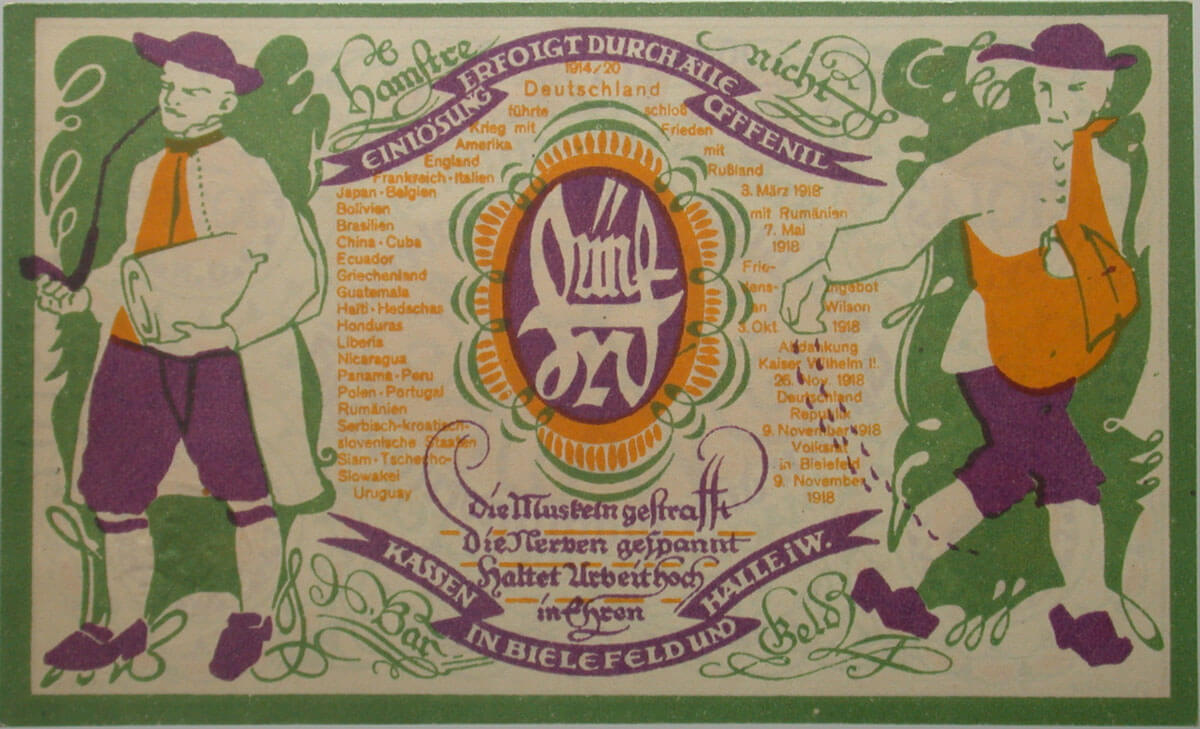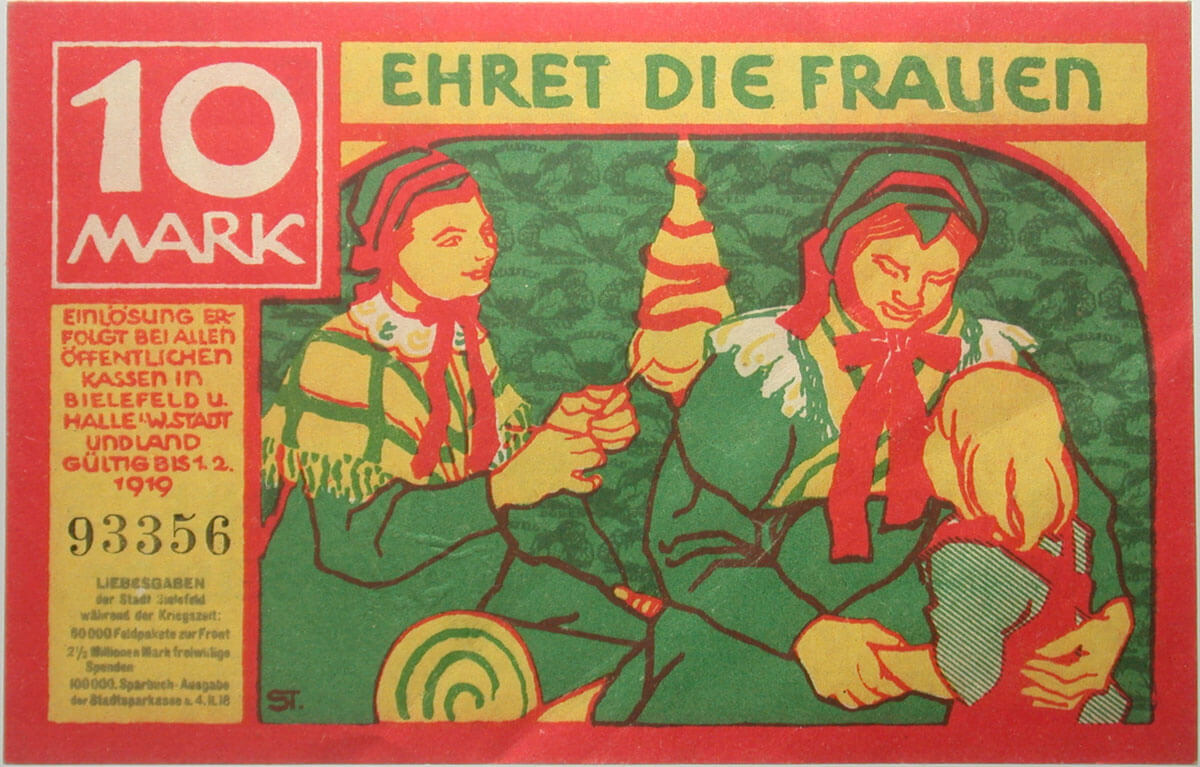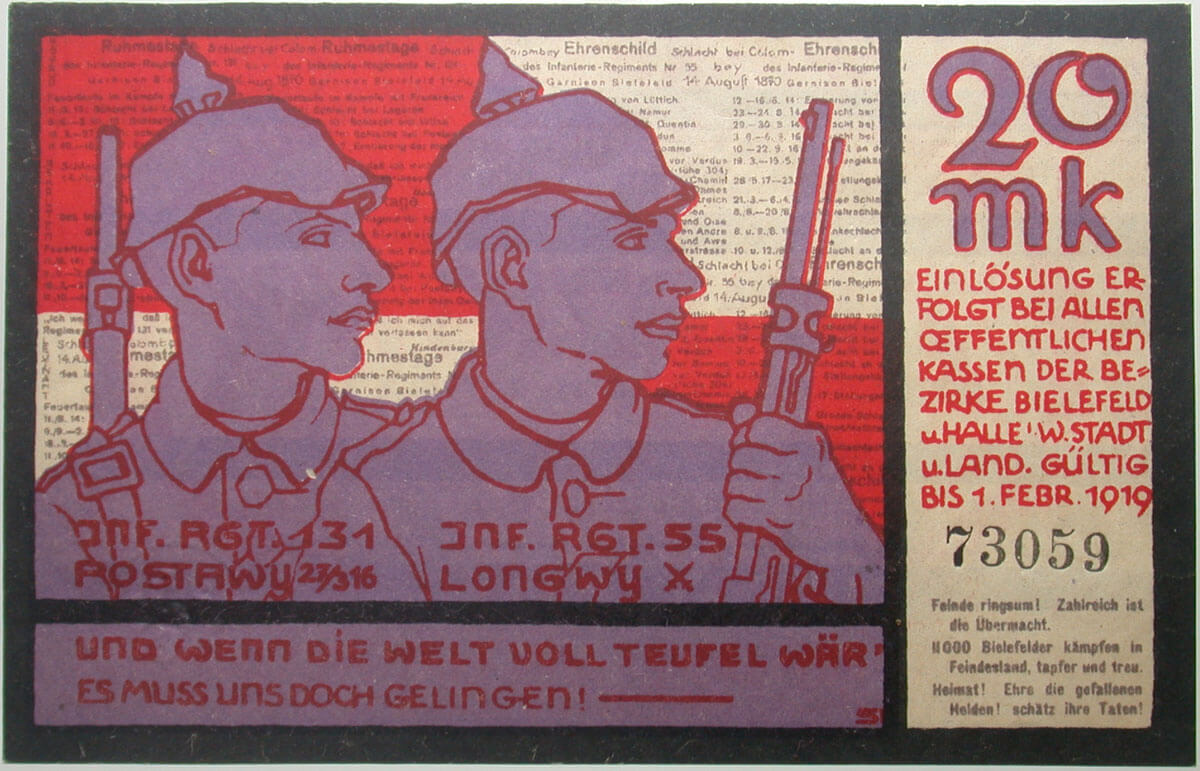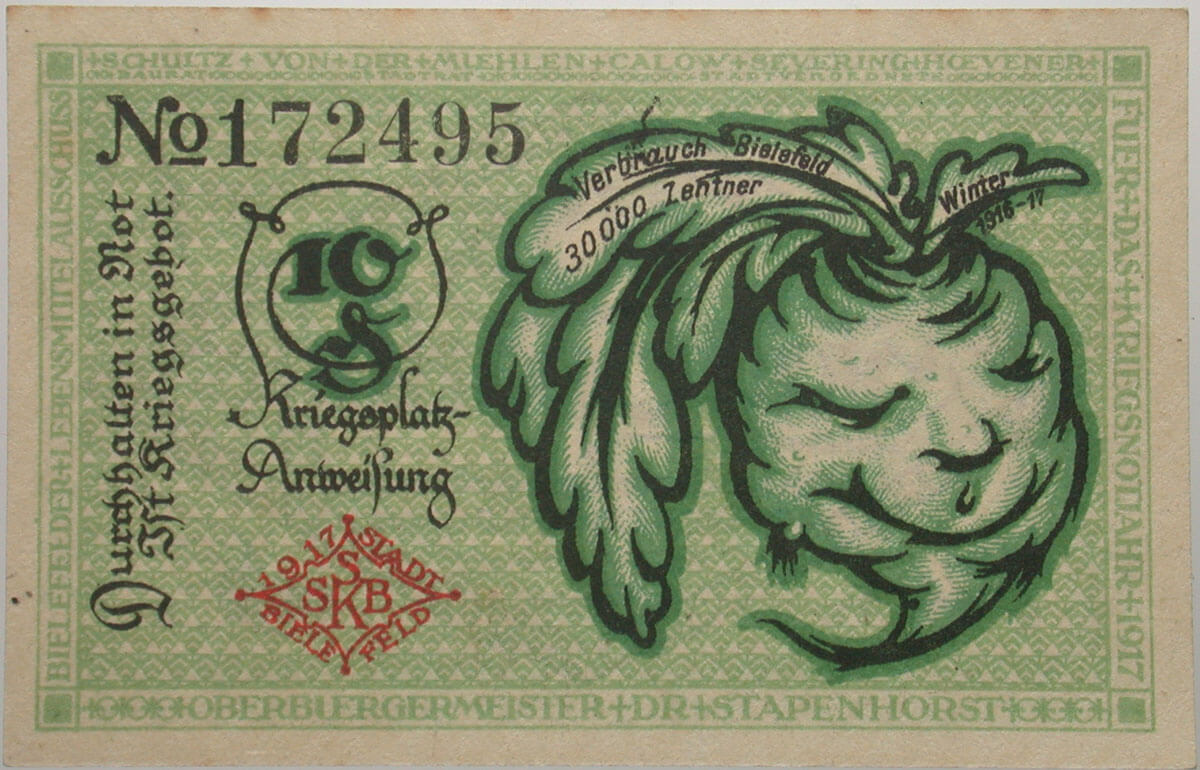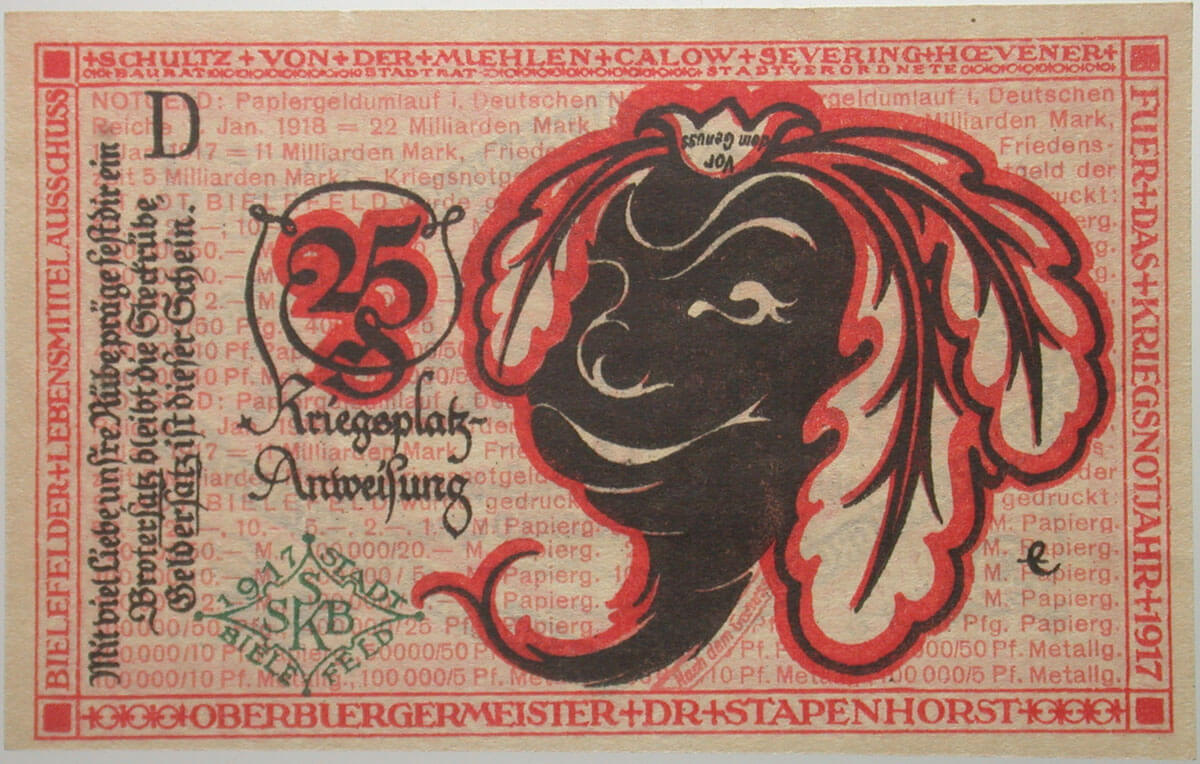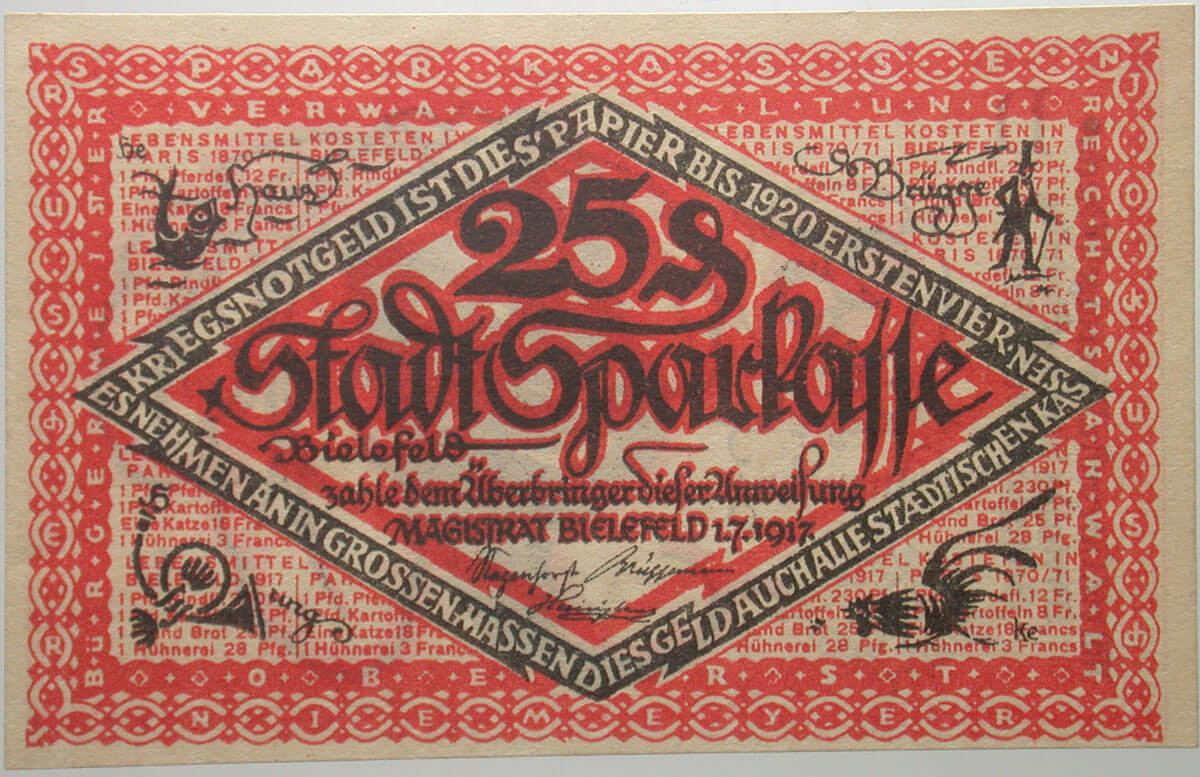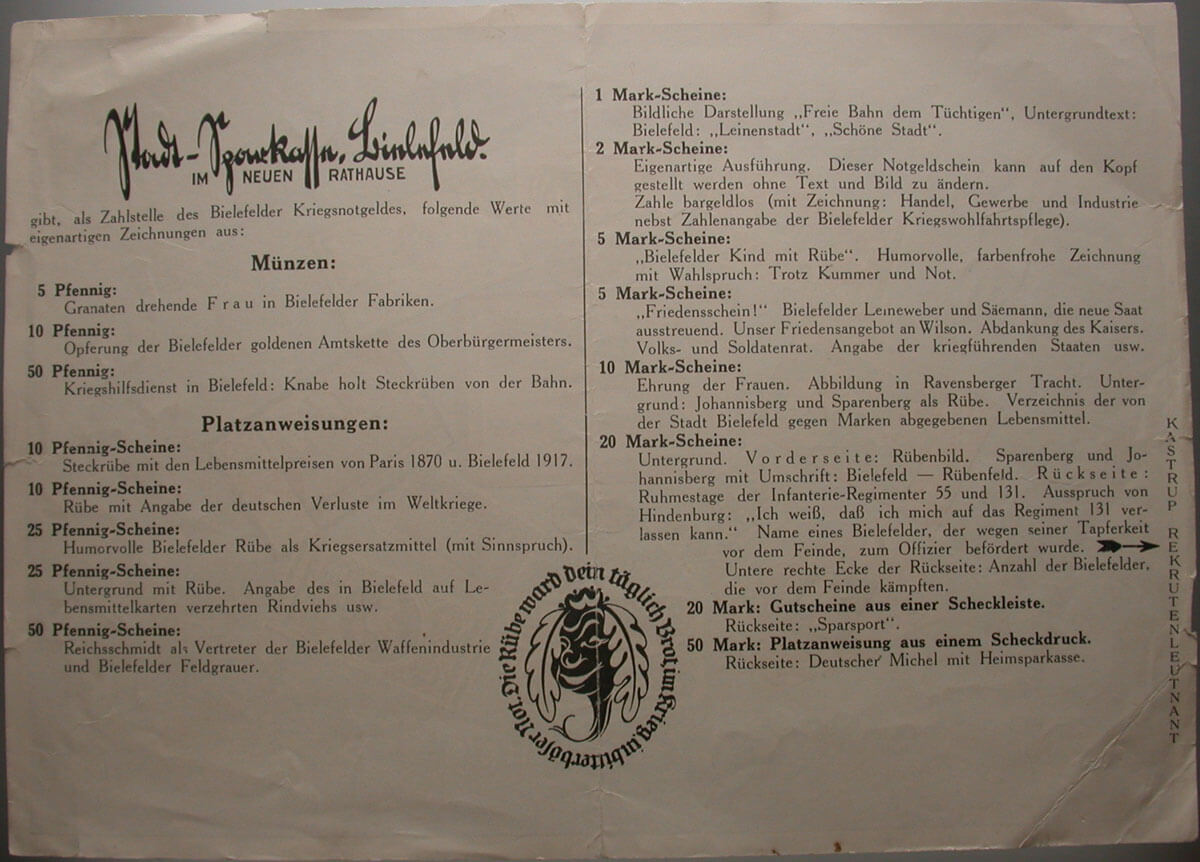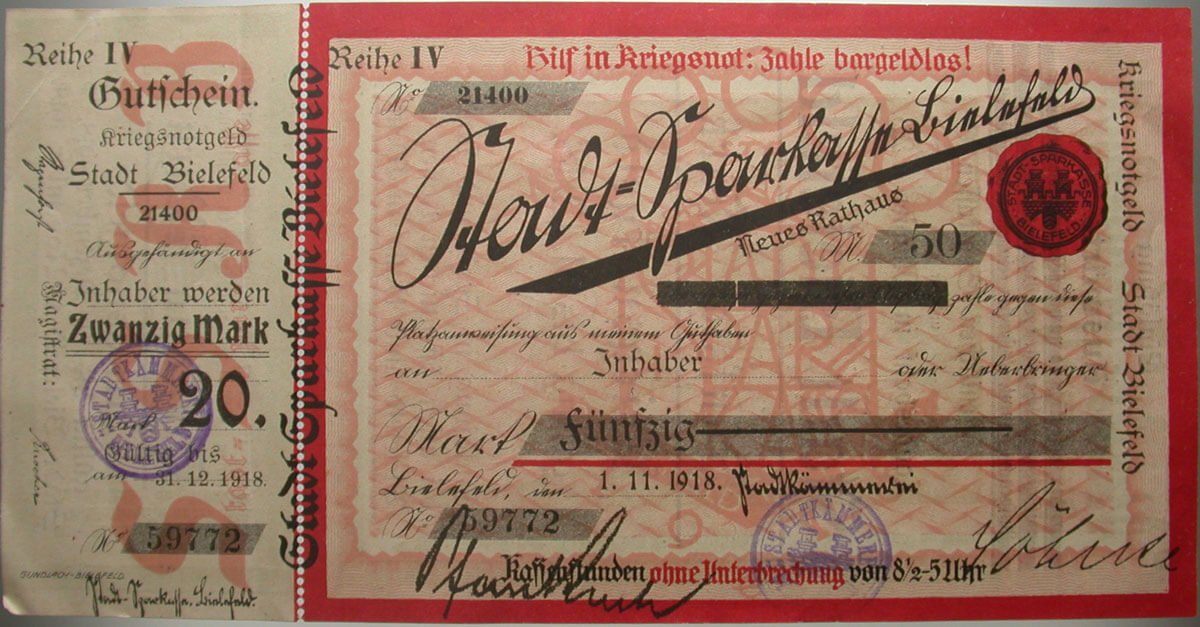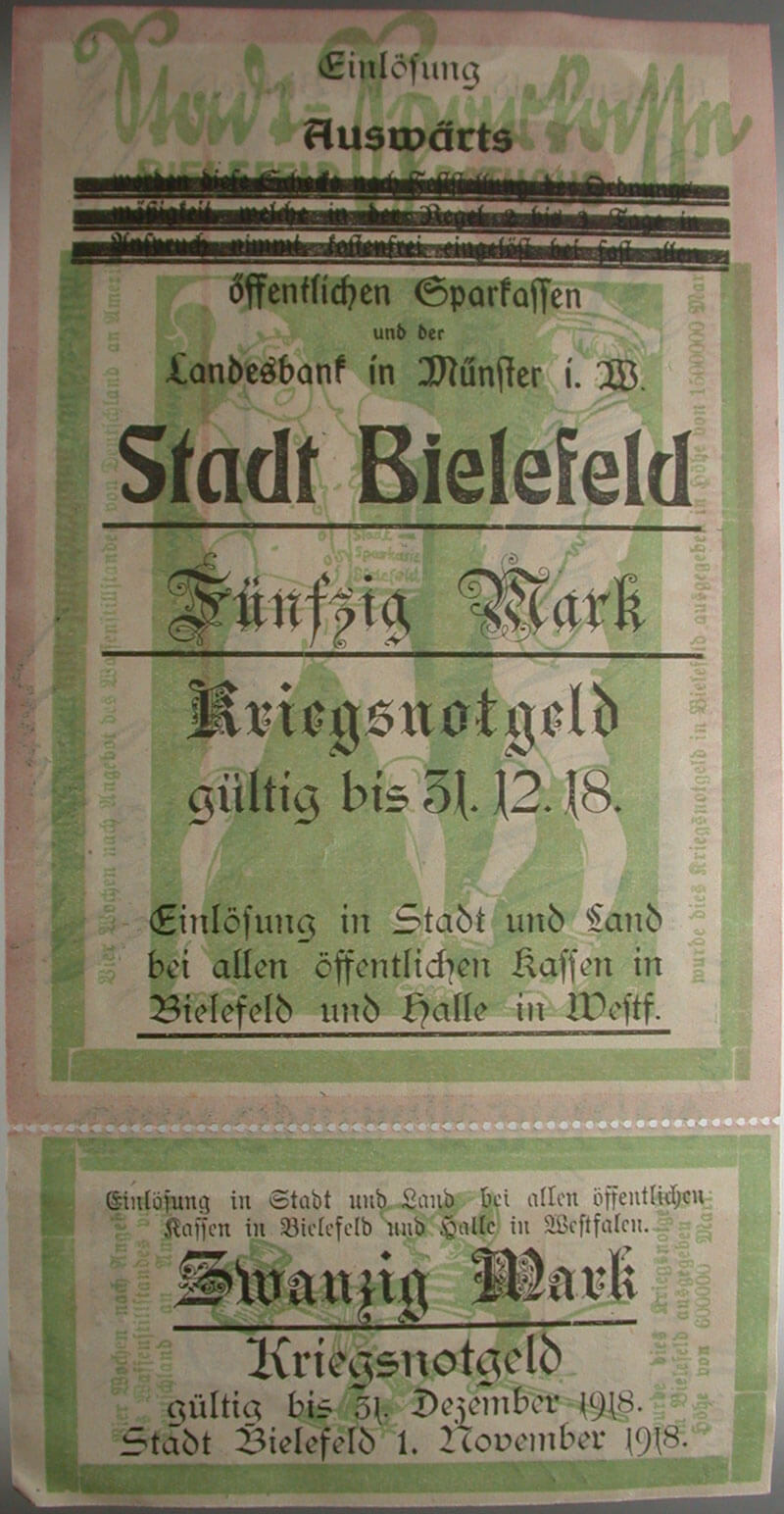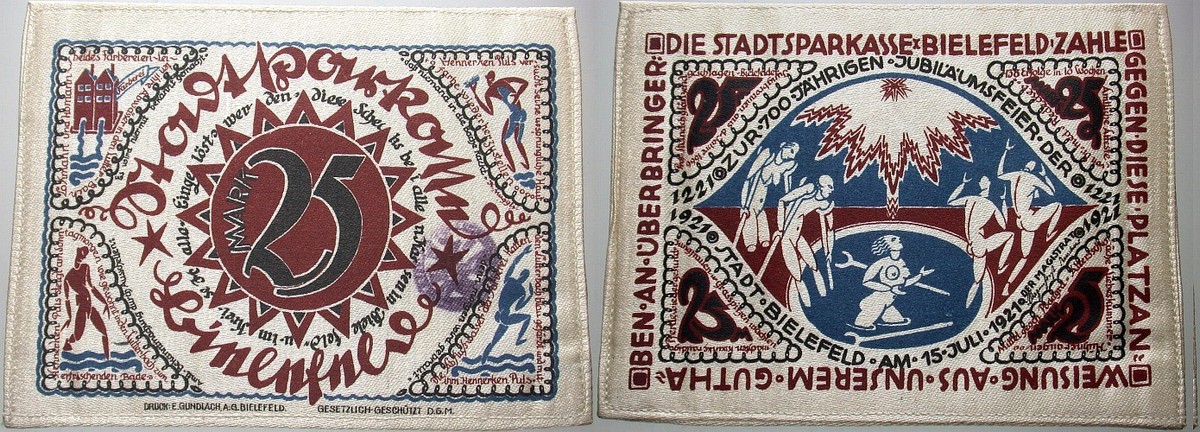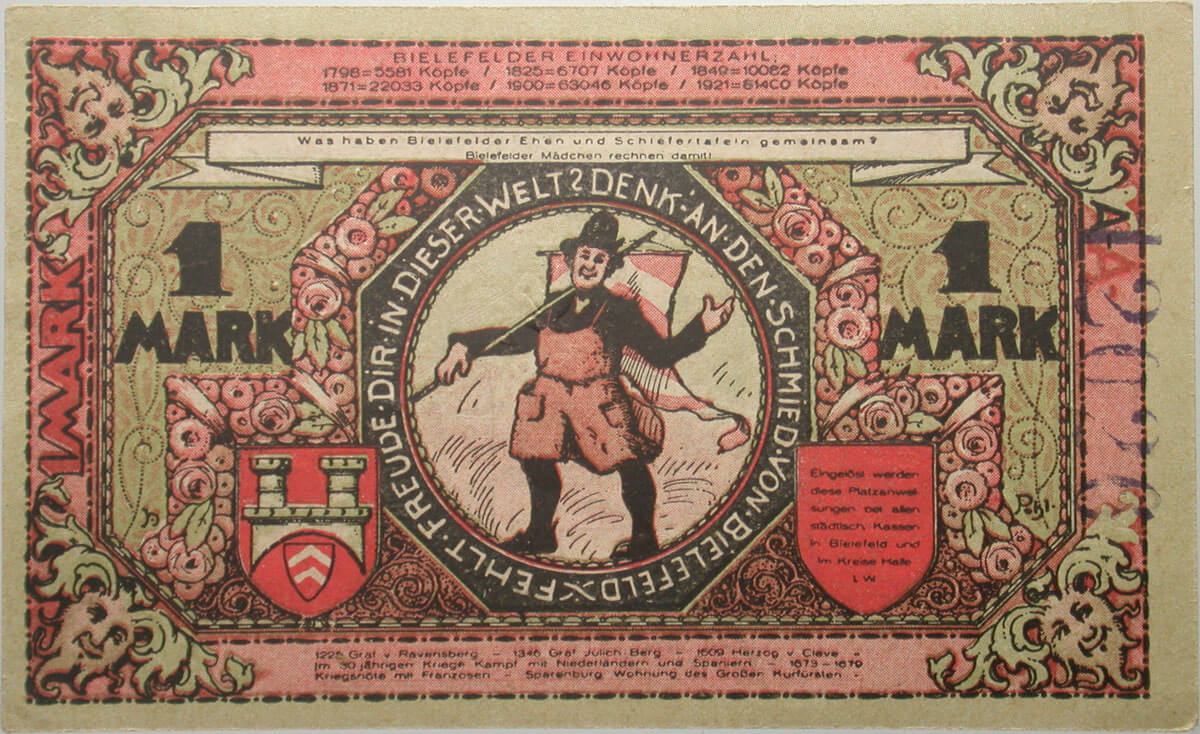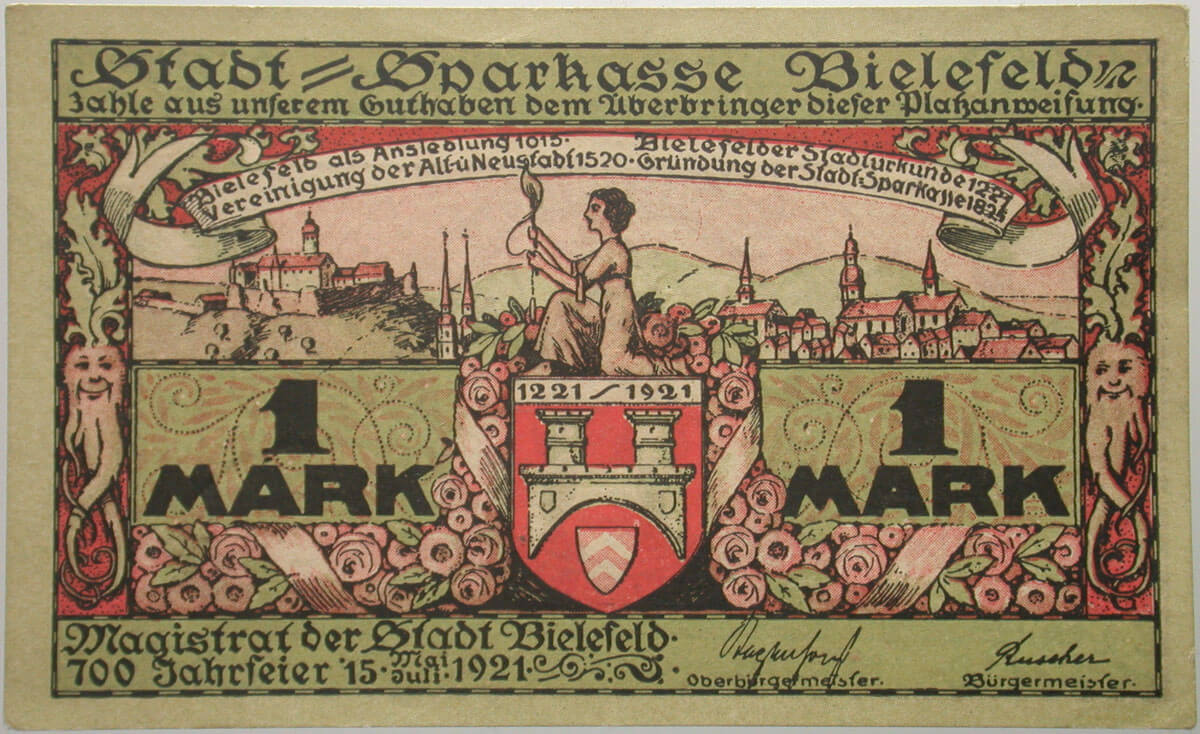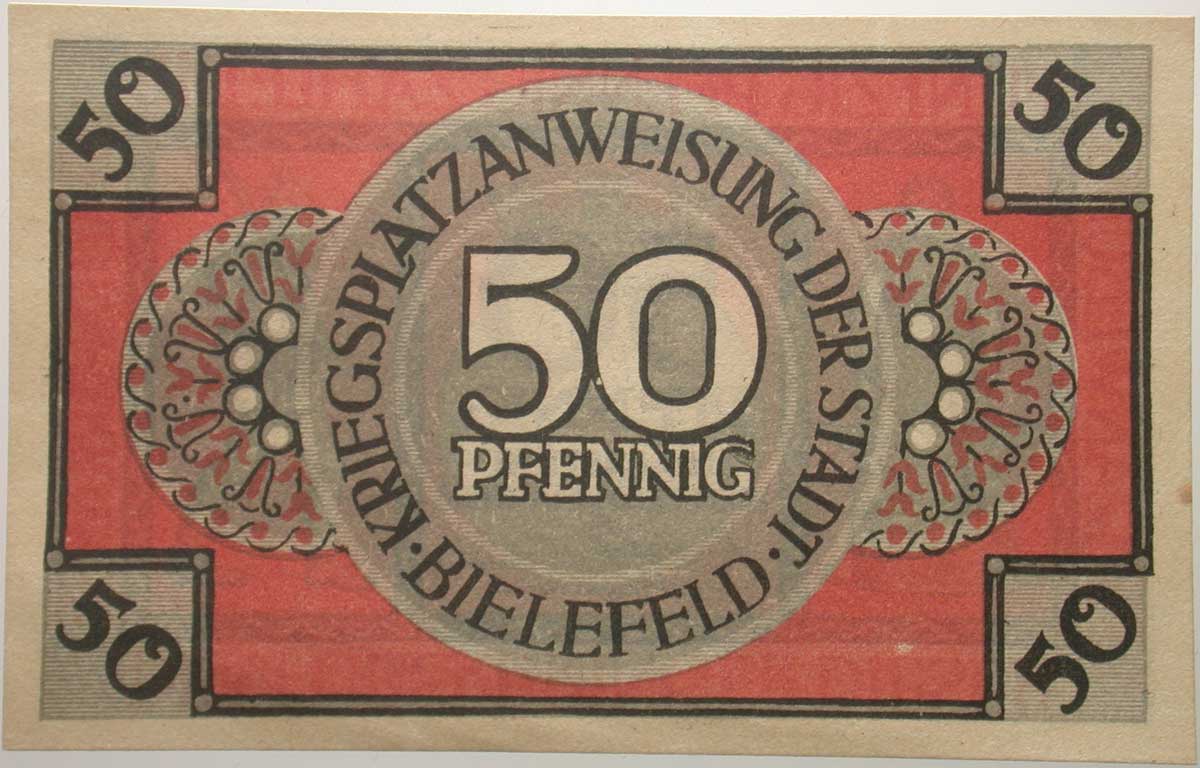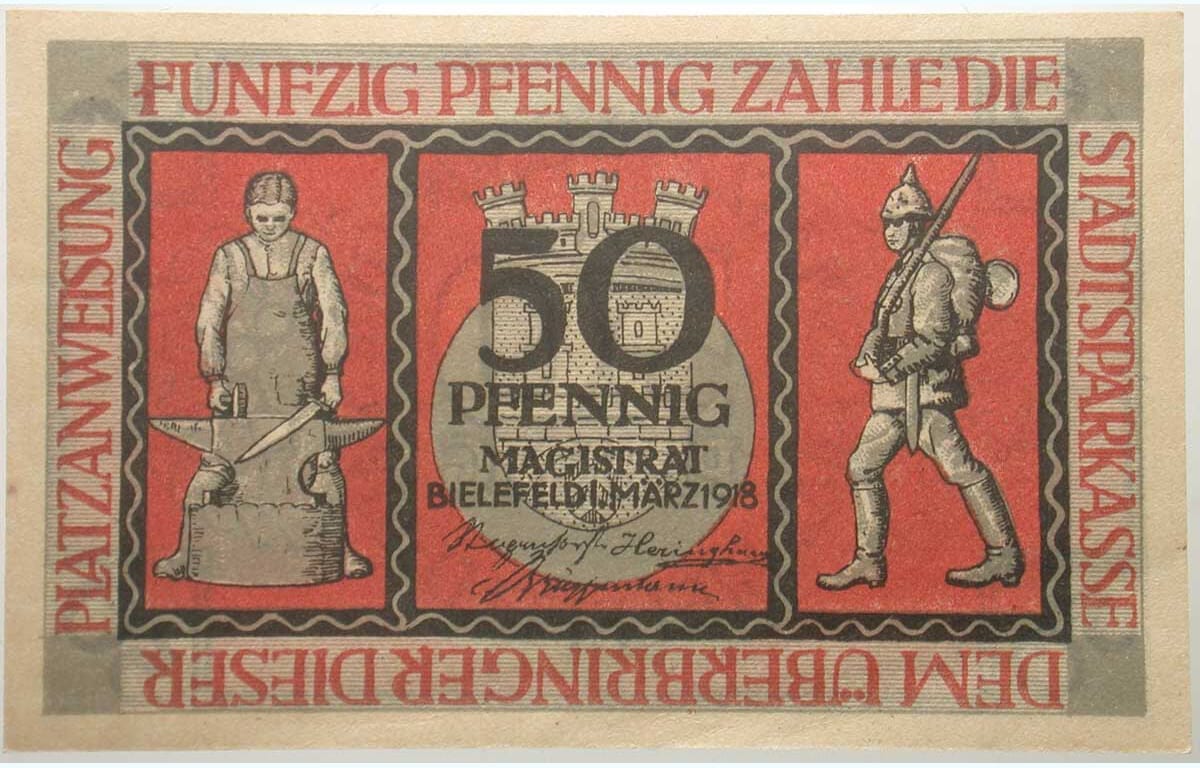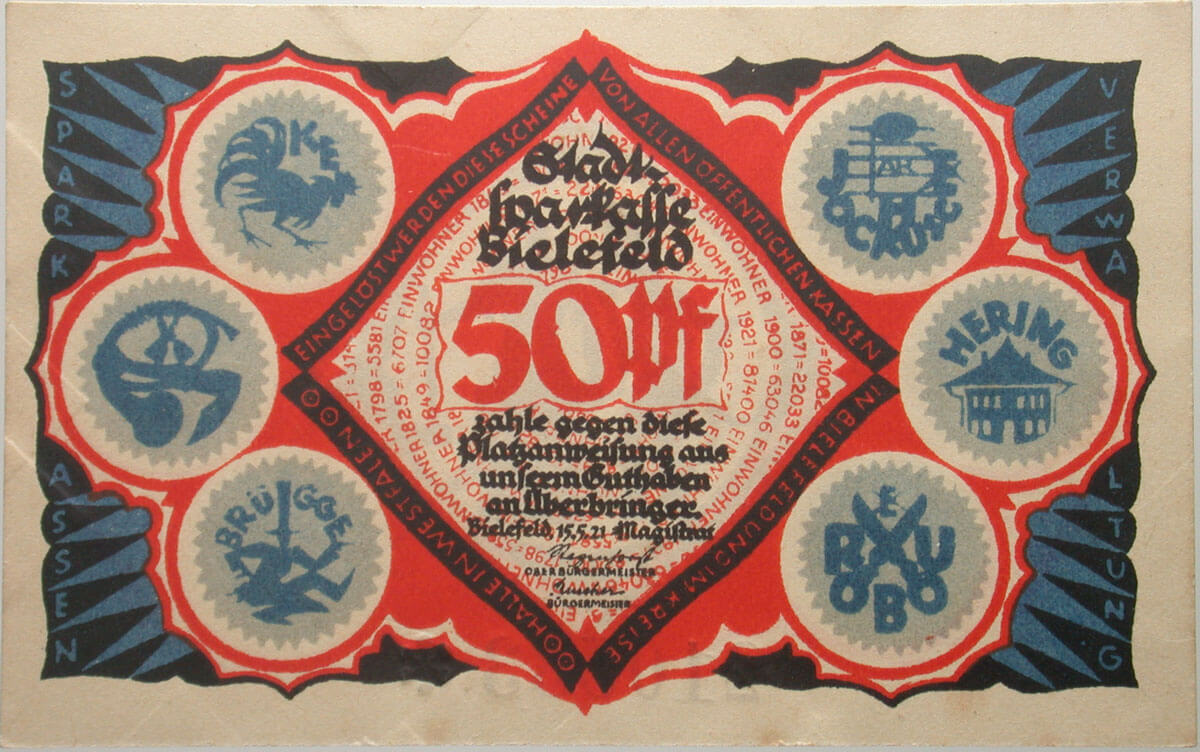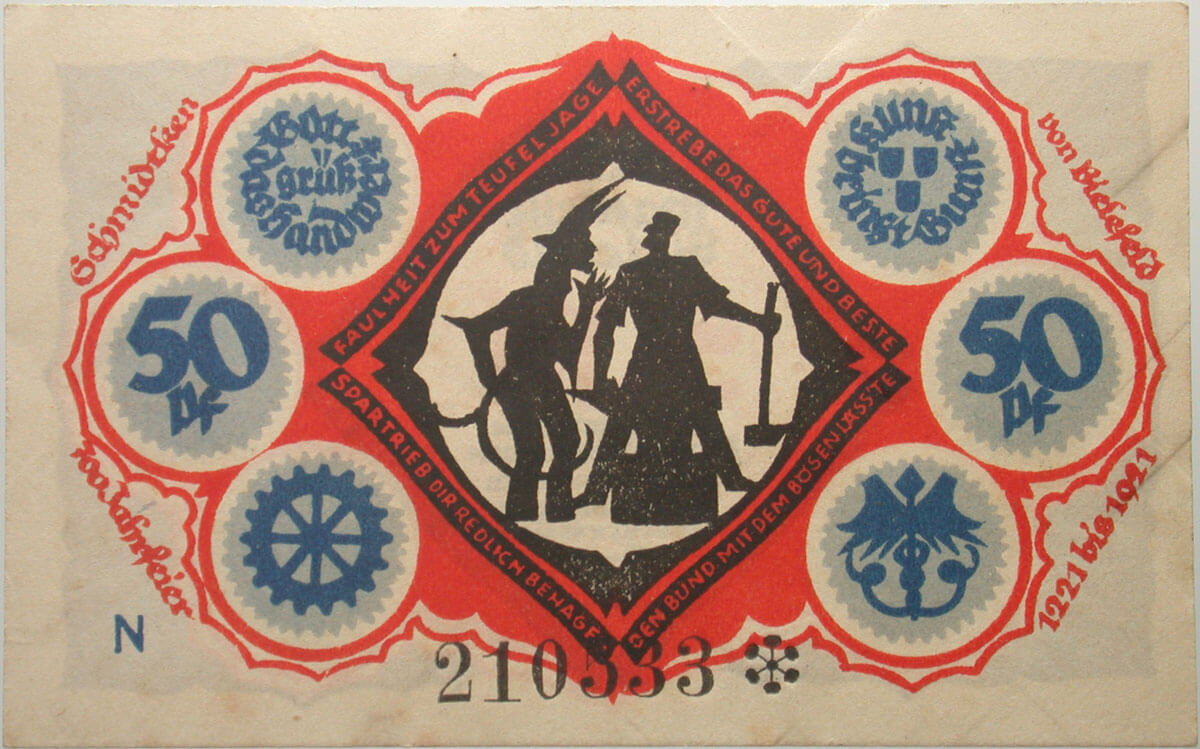Bielefeld stoffgeld
We are based in Bielefeld. Therefore, we are your specialists for Bielefeld stoffgelds [banknotes made from fabric]. Would you like to know more about them? Here, you will find an introduction into the subject and numerous explanations of the interesting motifs.
In the years after World War I, many cities in the German empire issued their own notgeld [emergency money]. At first, an actual shortage of coins was the reason, but later on, the notgeld bills, which were most often inexpensive to purchase, became a popular collectible. The city of Bielefeld was especially active and successful in the production of collectible notgelds.
The person responsible for that was Paul Hanke (1870-1945), director of the Stadtsparkasse [town savings bank] Bielefeld until 1925. He not only influenced the banknotes’ design, but also elaborately described them in local newspapers in order to recommend them to his citizens as memorabilia from the past. Especially on the occasion of the 700-year anniversary of the city of Bielefeld’s founding, he had plenty of notgelds issued. To set them apart from the competitor’s colorful bills, they were made from silk. As a special rarity for collectors, some banknotes were even hemmed with an elaborate trimming.
His article in the special anniversary edition of the magazine “Niedersachsen” of 1921 has been preserved, in which he soulfully describes a Bielefeld family in the year 2000, envisioning the history of their city with the help of these notgelds.
Please remember that this article is a historical source expressing the ideology of German upper classes of the interwar period. Certainly we do not share this view on the events of the First World War. But we thought that nobody could describe the Bielefeld notgelds better than the person who designed it.
It is winter, in the year of 2000. In the homey den of the single-family dwelling at Lehmstich street in Bielefeld, the weaver Hennerken Kralemeier is sitting. In thick clouds, he puffs away the Crüwell tobacco from a short soldier’s pipe, an heirloom of his grandfather’s. A cozy warmth fills the room. The town gas works provide the Bielefeld homes with the necessary fuel via a centralized heating plant. With curiosity, the ten-year-old son Christian looks at the beautifully-carved pipe bowl, knowing how much father cherishes the heirloom from the times of war. With this pipe, the grandfather had been portrayed as a linen weaver on the five-mark note of the city of Bielefeld on Christmas 1918.
When mother brought the steaming pickert [Westphalian potato dish] to the table and added pumpernickel bread with Westphalian ham and “real butter” from the city dairy, a satisfied grin crossed Hennerken Kralemeier’s face. “Yes, back in the day, when grandfather lived, and the bitter war taught the Bielefeld people what starving means, yes, back in the day, things were different, and looking quite bad” he said, putting a double layer of pickert, heavily covered in butter, on his plate. “‘Yes, Hennerken’ my grandfather said to me, ‘we had it quite scarce in Bielefeld at times. 850 horses, that is the number of two war-strength cavalry squadrons, a lot of money worth, we ate in Bielefeld in the three months of December 1917 until February 1918 alone. 50 grams of meat was our allowance, on 5 days a week, on stamps.’” “On postage stamps?” the ten-year-old offspring asks. “No, on meat stamps!” comes the reply. “Father, are those stamps made from meat?” “Silly boy” the father grumbles, “grandfather always recounted how food could only be bought from the merchant in exchange for small slips of paper that were issued at the townhall.” “Yes, yes” mother Kralemeier sighs, “my great-aunt Lohmann also remembered that time with terror, when she had to preserve the gooseberries from her yard without sugar. I inherited one of the many books the Stadt-Sparkasse Bielefeld had issued at the townhall, it tells exactly how to prepare several kinds of potato dishes without fat and how to make a tasty salad from nettles. For the entire month of May 1918, everyone in Bielefeld received no more than 250g of soup, 250g of pasta, 250g of morning dram, 900g of meats, that means less than two pounds of meat for four weeks, and 7 pounds of potatoes a week. You really had to arrange yourself back then!”
“Mother, how do you know all this?” the little one asks. “Well, son” the father proudly explains, “all that is written on the notgeld bills the city of Bielefeld issued over 80 years ago. On the ten-mark bill, next to two women in fancy Ravensberg costume, is written the motto: Honor the women! And then there is also a verse, printed very small:
Der Krieg ist kein Schlaraffenland,
Mit Brot und Fleisch war’s knapp bestellt,
Doch half der Hausfrau Meisterhand
Durchhalten, in dem Krieg der Welt.
[The war is no paradise,
Bread and meat were scarce,
But the housewife’s masterful hand
Helped endure in the World War.]
And below there are listed all the numbers and foods your mother just mentioned.
Now go into the parlor and, from the bureau’s lower drawer, get out the album with the war diary and the war notgelds from the Stadt-Sparkasse.” Proudly, Christian brought what he had been sent for. Neatly, two notgeld banknotes were attached on each page. This arrangement was especially convenient and nice, for each bill existed twice. At once, one could study the front and the reverse side. The free space on the side of the cardboard pages bore the grandfather’s handwritten notes, explaining the specialties of the Bielefeld war emergency banknotes. “Yes, my son” says Hennerken Kralemeier, “look how nicely grandfather thought of us; this collection of notgelds was compiled in order to bear witness to grandchildren and great-grandchildren of the bitter times when 11,000 Bielefeld men fought against 29 enemy states. Your grandfather fought bravely; the Iron Cross and a shot through the big toe is what he brought back from the battlefield. At first, Grandfather was with the 55ers, then with the 131ers, those are the two infantry regiments that used to be based in Bielefeld. Look here, the twenty-mark bill of the Stadt-Sparkasse: On the back, there is a saying from the great field marshal von Hindenburg: ‘I know that I can rely on the regiment 131.’ Look at this spot that you can clearly see standing out from the background under the magnifying glass, your grandfather often showed it to me with great pride. ‘Son’ he would say to me, ‘remember your grandfather later, the days of honor that are printed on the city’s bill next to the beautifully drawn soldier heads show the dates where our Bielefeld men fought for our beloved home with Frenchmen and Russians, Englishmen and Americans, blacks and whites. If you can make out the row of letters to the left on the back of the twenty-mark note, you are reading the name of our brave Bielefeld recruit lieutenant: Kastrup, who was promoted to officer for his courage before the enemy. Us Bielefeld men, we fought bravely. The motto on the twenty-mark note: Und wenn die Welt voll Teufel wäre, es muß uns doch gelingen! [And if the world should be full of devils, we must succeed!], that was our battle cry when we, with Westphalian fists and full of inner rage, taught the enemy a lesson!’”
On the notgeld at 10 pfennigs, you can read the food prices paid in Bielefeld in 1917 and in Paris in 1870. In 1917, a chicken egg in Bielefeld cost only 28 pfennigs. But potatoes were so rare that, in the winter of 1916/17, 30,000 hundredweights of turnips were eaten in Bielefeld.
When you look at the 25-pfennig bill, you can see, by the turnip with a face, designed by the Bielefeld art teacher Eich, what a Bielefeld citizen looked like “before the indulgence”, and when you turn the bill around, you see how they would make a face “after the indulgence” in the turnips. On every notgeld bill of the city of Bielefeld, you see new war memories, preserved in words and images. For hours, you can delight in looking at the banknotes. Those colorful, splendid bills unite Westphalian customs and cultural history, war memories and artistic capacities in their lively drawings.
If you want to know when Germany sent off the truce offer to America, to President Wilson, or if you want to read up on when peace with Romania or Russia was made, or on which day Emperor Wilhelm II resigned and Germany became a republic, or when the People’s and Soldiers’ Council convened in Bielefeld, you only have to look on the five-mark note. It also shows the names of all the 29 states Germany was at war with. All the banknotes issued by the Stadt-Sparkasse Bielefeld together build a self-contained whole. United like in a book of remembrance, you can find all those war pictures artistically preserved that make the history of our home Bielefeld dear and valued to you.
When grandfather was in the field on Christmas 1917, our troops had entrenched themselves. From the city of Bielefeld, grandfather received one of the 60,000 care packages that the Bielefeld war aid had sent out into the world as gifts of love. The Christmas package included a prize challenge from the Stadt-Sparkasse. Our Bielefeld lads were asked to submit a poem or a drawing of the Bielefeld turnip for the banknotes; the best submissions were to be awarded special prizes. Now, can you imagine, son, what great fun that was? Half a wagonload of poems was sent to the Stadt-Sparkasse Bielefeld. The turnip design from the ten- and twenty-mark bills ‘Bielefeld, Rübenfeld’ [Bielefeld, turnip field], which was rendered in small on the ten- and twenty-mark bills, had been drawn by a Bielefeld soldier in the trench.
The two-mark note can be held upside-down, it looks the same from above and below. The war editions of the city of Bielefeld feature exact numbers of usage.
The one-mark note bears the slogan ‘Freie Bahn dem Tüchtigen’ [free passage for the hardworking] and the background ‘Bielefeld, Leinenstadt, schöne Stadt’ [Bielefeld, city of linen, city of beauty]. The people’s humor got a good hold of the one-mark bill: The vaulting soldiers on the reverse have been interpreted as Minister Severing, who used to be city councilor of Bielefeld, leaping over the Bielefeld mayor, through his appointment as minister.
The fifty-mark note is particularly interesting, with an attached strip of checks at 20 marks. This bill was emergency money in the truest sense of the word. The necessary funds for paying the war benefits to the soldiers’ wives were missing. The state treasuries had not received any money, so the town treasuries had to pay in order to avoid unrest among the citizens. Yet money was nowhere to be found. Overnight, the Stadt-Sparkasse’s check forms were equipped with the print ‘50 M’ and the strip of checks with ‘voucher 20 M’. The banknotes, not even dried yet, were able to eliminate the shortage of money. Not only the town banks, but also the central bank Reichsbank and the other financial institutions used the Stadt-Sparkasse’s fifty-mark bill with the voucher strip of 20 marks as notgeld. The bills went off like hotcakes, directly from the printing press into circulation.”
“Yes, father” says Christian, who had followed his father’s explanations with bright eyes, “here on the following pages in the album, there are even more artistic vouchers with the ‘Bielefeld healing pool’ and the ‘Bielefeld blacksmith’, what does that mean?” “Look, son” the father explains, “these new bills are from a second series, covering Bielefeld’s history of 700 years. In the olden days, Bielefeld belonged to the county of Ravensberg. War and terror of the ThirtyYears’ War did not leave the Bielefeld town of linen untouched. The fight against death and devil, sickness, plague and women’s schemes, is illustrated with these notgelds. You have surely read about Professor Steinach in some old book, who, 80 years ago, wanted to rejuvenate the elderly. Now, you see, the Bielefeld people already had a so-called fountain of youth four hundred years ago. The very fine silk 25-mark note that you see here is the gem of the collection, drawn with artful line management many years ago by Mr. Muggly, teacher at the Bielefeld School of Arts and Crafts, who passed away in 1999. Mr. Muggly had a skillful hand at glass painting. At the war memorial on Oberntorwall, there is still the little weather house with the pretty, colorful mosaic glass works he made.
Bielefeld used to be a spa town until 1666. On the Köttelbrink, which would later become Kaiser-Wilhelm-Platz, where today there is the forum with the magnificent townhall, the large reading halls and the Stadt-Sparkasse with the town bank, which, at an interest rate of 3.5 % for check money, makes a turnover of 120 million a year, and which is so large that you can drive from one department to another with a town automobile, on that square, there used to be the Bielefeld healing pool. 438 healings were achieved within ten weeks. Doctor Redecker, who also used to be the mayor of Bielefeld, confirmed this, as you can read on the two-mark note issued on occasion of the city’s 700-year anniversary. Professor Steinach tested his rejuvenation cure mostly on rats and bunnies and only few humans. The fountain of youth so humorously depicted by Mr. Muggly, where old maids step in with their canes, only to come out in vibrant beauty, fresh and youthful, shows the stunning successes of the Bielefeld rejuvenation treatment for the fair womanhood. Until today, on the Bielefeld Obernstrasse, you only ever see beautiful young girls. Professor Steinach has been brilliantly defeated!!!
The funny corner images on the 25-mark bill are cheerful and lusty, showing Hennerken Puls, a true Bielefeld character, taking a bath in the Lutter creek on a Sunday morning. The Bielefeld dyeworks led their wastewater and dyes into the Lutter creek. Hennerken, slightly inebriated, did not think of that, stepped into the creek naked and suddenly noticed with shock that he was dyed completely blue. His efforts to ‘whitewash’ himself afterwards failed miserably, to the great exultation of the Bielefeld youth. But keep listening: When Bielefeld was still a small linen weaver town, all public notices were announced by the council’s attendant. The bleacheries and dyeworks on the Lutter creek were warned not to pollute the creek with their wastewater on the days when the breweries brewed their beer. This was done in a humorously drastic fashion by crying out:
Es wird hiermit bekannt gemacht,
daß niemand in die Bache ‚spuckt‘
denn morgen wird gebraut.
[Let it be known,
No one ‘spit’ in the creek.
Tomorrow is brewing day.]
This and other memories of Bielefeld joys and sorrows are illustrated with the new series. The 25-mark bill is printed on Bielefeld silk by the company Gundlach of Bielefeld. There are also anniversary notes made from Bielefeld linen, the fruit of our Bielefeld industriousness. Numerous lovers of the unique Bielefeld notgelds have expressed their lively interest by strong demand for the new banknotes. Bielefeld wants to go its own way as regards notgeld. Not imitation, but individual character, Westphalian customs and Ravensberg creative urge are suitably expressed in those novelties.
One- and two-mark bills feature, apart from statistical data from the 700-year history of our hometown, Bielefeld specialties in highly artistic design. House labels, like the ones still attached on the old Bielefeld jewelry house today, can be found on the banknotes. As the noble courts used to show their coat of arms, Bielefeld citizens had gotten themselves house labels in the 16th and 17th century. Similar to today’s factory brands, those labels were preserved in the family from generation to generation. Husband and wife often had similar labels with slight deviations. People who could not write used their house labels as personal signature. On the gable of the Consbruch house on Obernstrasse, which today makes the beauties of the ancient house visible once more, in the upper part, you can see the house label which is also represented on the Bielefeld banknotes. Someone who would like to learn about all the countless specialties featured on the bills should get themselves a master collection of the Bielefeld artistic efforts.
For its banknotes, the city of Bielefeld also adopted the old Westphalian tradition of attaching inscriptions on farmhouses. Lusty images, as they can be found carved into the wood on the gables in colorful design, are present in Bielefeld notgelds as well. All bills bear mottos fitting the down-to-earth character of our Ravensberg people. On the smaller banknotes at 10, 25 and 50 pfennigs, you will find the names of the members of the savings bank administration in rebuses: Heringshaus, Horn, Ruscher, Jockusch Brüggemann, Hanke. Old legends from earlier centuries resurface on the 50-pfennig bills issued for the 700-year anniversary.
Look, son, the silhouettes on the 50-pfennig bills are masterpieces. They were produced in black-and-white fashion by Mr. Schreiber, co-owner of the Bielefeld art printing company Klocke & Schreiber. In earlier centuries in Bielefeld, hand weaving developed into machine production. The silhouettes, too, have gained world renown during the last 80 years. The Bielefeld notgelds were sent to America and Spain, to Switzerland and Holland. The artistic silhouettes found such great appreciation that the city of Bielefeld founded its own shear factory. On the street Am Grünen Winkel where the Heepen spruce trees stand, you can see the many little cottages where the 800 employees live who work at the town shear factory. Grandfather always said, ‘Cherish the notgeld bills.’ The unique, artful banknotes increase in value every year and constitute a big fortune today.
For a single copy of the old Bielefeld five-mark coin, 28,000 marks cash were already paid in 1918. The complete collections of notgelds will be very much sought-after in the future. A Vienna privy councilor once wrote: ‘With its notgelds, Bielefeld has created a work of cultural-historical importance.’ One day, you will receive the collection as an heirloom. Mother and I believe that the collection’s value will some day enable you to purchase your own debt-free estate.”
Bielefeld. Paul Hanke. 1921

